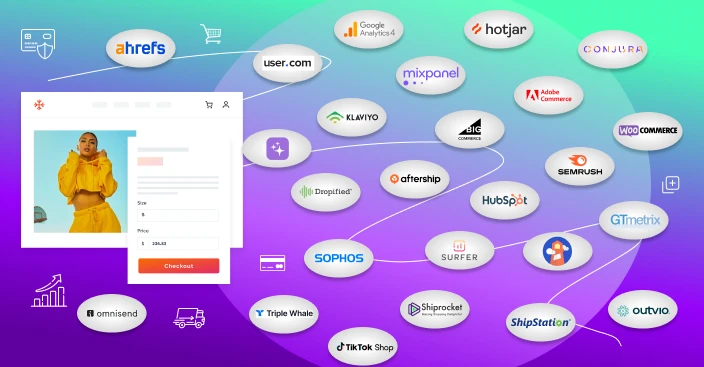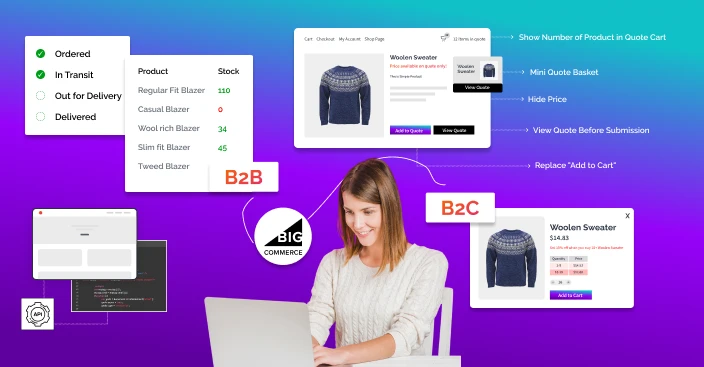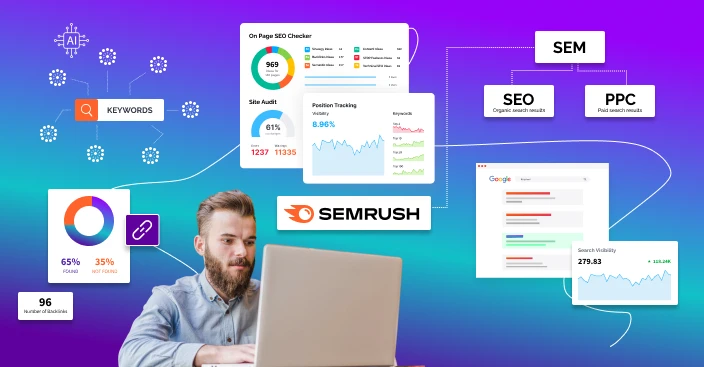Best E-commerce Applications That Boost Online Business in 2025–26

Table of Contents
The e-commerce industry has changed considerably and stil transforming layer by layer. Online sales are expected to reach $7 trillion globally, and people are making transactions more often than they used to do before. Whether it’s quicker distribution or more intelligent product recommendations, online businesses already use the latest tech innovation to improve customer experiences. The good applications can help you grow your business, save time, and keep your customers happy if you’re operating an online business.
The success of your web-based business can be impacted by the apps you use. Using the right e-commerce solutions can help you operate more efficiently, increase sales, and maintain customer satisfaction, whether you’re just starting out or want to grow.
1. Adobe Commerce
Adobe Commerce, previously referred to as Magento, is a highly customizable and extendable e-commerce platform for complex store layouts.
Key Capabilities:
- Visual search and product suggestions driven by AI
- Smooth interaction with Adobe Experience Cloud and Analytics
- Customization according to user groups and current actions
Perfect For:
- Enterprise companies with internal resources for development
- Retailers that are multilingual and multi-regional
- Website of the company: adobe.com/commerce
Official Website: adobe.com/commerce

2. WooCommerce
WooCommerce is the most popular open-source e-commerce plugin among WordPress users. It has a large ecology of extensions and is highly adaptive.
Why It’s Still Popular in 2025:
- Better integration with Jetpack and AI-driven performance tools
- Easier international selling with region-based tax settings and multi-currency plugins
- Extensive theme and plugin support
Who It’s For:
- Bloggers and content creators transitioning to e-commerce
- Brands already leveraging WordPress
Official Website: woocommerce.com
3. BigCommerce
Both B2B and B2C businesses have found a place for BigCommerce, a feature-rich SaaS e-commerce platform. With a focus on flexible integration and headless commerce, it continue to grow in 2025.
Why Choose BigCommerce:
- Support for complex catalogs and high-volume operations
- Built-in B2B features include custom pricing, quotation management, and client groups.
- Advanced APIs provide complete control over the frontend and backend architecture.
Use Case: Ideal for mid-market and enterprise-level companies seeking performance and growth.
Official Website: bigcommerce.com

4. Shopify (With Magic AI)
Shopify has dominated the hosted e-commerce platform sector for years, and it is still the most trusted choice in 2025. Shopify now includes Magic AI and the Sidekick helper, allowing merchants to easily establish and manage their online stores.
What’s New in 2025:
- Magic AI helps write product descriptions, create discount codes, and even generate customer support replies
- The new Shopify Sidekick can answer business-specific queries and automate daily tasks
- React-powered Hydrogen + Oxygen framework for headless store flexibility
Best For:
- Solo entrepreneurs
- SMBs looking for rapid go-to-market solutions
Official Website: shopify.com
5. Klaviyo
Strong email and SMS marketing automation designed especially for e-commerce firms is provided by Klaviyo.It is well-known for its broader interface with WooCommerce, Magento, and Shopify.
What Sets It Apart:
- flexible segmentation based on customer behavior (e.g., past purchases, amount of time spent looking, and value of cart)
- Pre-made workflows for product restocking, win-back campaigns, and cart abandonment
- Analytical forecasting, such as projected customer lifetime value (CLTV)
Best For:
- DTC brands focused on retention
- Stores with 10K+ subscriber lists
Official Website: klaviyo.com
6. Google Analytics 4 (GA4)
Google Analytics 4 has become an important Analytics software for e-commerce entrepreneurs. With event-based tracking and real-time reporting, GA4 provides insight into consumer journeys across devices.
Why does it hold significance in 2025?
Following Google’s ban on third-party cookies, GA4’s machine-learning-powered predictive analytics (such as purchase likelihood) can help marketers modify their strategies and increase conversion rates.
Key Benefits:
- Universal tracking (web and app)
- based on AI predictive analytics
- Integration of Google Ads and Data Studio
Official Website: analytics.google.com
7. Mixpanel
Mixpanel offers advanced funnel tracking, user segmentation, and cohort analysis for e-commerce teams. Unlike traditional analytics, it focuses on tracking user activity.
Why this matters: In 2025, product teams will depend on Mixpanel to find out which behaviors contribute to conversion and retention.
Official Website: mixpanel.com
8. The Hotjar
Hotjar helps you see user interactions on your business by combining session records, heatmaps, and user feedback tools.
New for 2025: It now offers automated recommendations for UX enhancements thanks to its AI-driven behavior detection. Store owners may take immediate action by recognizing scroll drop-offs, anger clicks, and abandoned checkout routes.
Perfect For: Conversion path optimization by UX designers
Owners of small businesses increasing on-page interaction
Website official: hotjar.com
9. Conjura
Conjura is designed for e-commerce operators that are data-hungry and want metrics that go beyond the obvious. With its smooth integration, it provides detailed data down to SKU-level profitability with systems like Shopify and WooCommerce.
Why Make Use of It: Scaling for profit is crucial in 2025. Conjura provides a single dashboard for data-driven choices about marketing attribution, client lifetime value, and inventory.
Who It’s For:
- Brands with large catalogs
- Teams optimizing operational and marketing efficiency
Official Website: conjura.com
10. Omnisend
Omnisend is a quickly growing multi-channel marketing tool intended to make campaign creation easier for online merchants.
Top Features:
- Editor for drag-and-drop automation
- Created e-commerce workflows for post-purchase messaging, cart recovery, and welcome.
- Omnichannel compatibility includes WhatsApp, push notifications, SMS, email, and other features.
The Reason it Works in 2025: Omnisend’s AI-powered send-time optimization and one-click Shopify integrations are excellent for expanding businesses with small marketing teams.
Why It Works in 2025: Omnisend’s based on AI send-time optimization and one-click Shopify integrations are excellent for businesses growing with small marketing teams.
11. HubSpot for E-commerce
Your online store may be simply linked with HubSpot’s comprehensive suite of inbound marketing solutions. It is an effective solution for nurturing leads and driving conversions since it combines CRM, email marketing, live chat, forms, and automated procedures.
2025 Advantage:
- New chatbots with AI capabilities for instant customizing
- Improved dashboard for reporting on e-commerce data, such as customer lifetime value (LTV) and AOV
Ideal For:
- Stores looking to manage content, email, and leads in one place
- Brands focused on inbound marketing
Official Website: hubspot.com
12. SEMrush
SEMrush is one of the most useful tools for analyzing competition, SEO, and SEM. It assists e-commerce businesses in increasing their search engine rankings and online visibility.
New for 2025:
- AI-generated keyword clusters for product optimization
- Smart link-building tools with outreach automation
Use Cases:
- Identify high-volume product-related keywords
- Track your and competitors’ performance across markets
Official Website: semrush.com

13. Ahrefs
Ahrefs is best known for its backlink checker and SEO suite. In 2025, it’s a must-have tool for content-driven e-commerce stores.
Why Choose Ahrefs:
- Extensive database of backlinks
- Site audit tool to identify SEO issues
- Keyword explorer with SERP volatility tracking
Great For:
- Brands relying on organic traffic
- Content marketers and affiliate stores
Official Website: ahrefs.com
14. Surfer SEO
Surfer SEO provides AI-driven content optimization to improve rankings and content relevance.
Why It Matters: In a time where Google’s algorithm focuses heavily on user intent and topical authority, Surfer helps your product descriptions and blogs stay ahead.
Features Include:
- Real-time SEO score for content
- Competitor page analysis
- NLP keyword integration
Official Website: surferseo.com
15. Core Web Vitals + Lighthouse
Google’s Lighthouse and Core Web Vitals have become essential metrics for user experience and search performance.
In 2025:
- Google’s algorithm weighs performance heavily
- FID has been replaced by INP (Interaction to Next Paint), making it essential for stores to monitor interactivity
What You Can Track:
- Speed Index
- First Contentful Paint
- Layout shifts
Official Website: web.dev
16. GTmetrix
GTmetrix is still a top tool for performance optimization and website speed testing.
Why It Will Be Helpful in 2025: Since 73% of sales are made through mobile devices, GTmetrix aids in optimizing load speeds for various devices and geographical areas.
Key Benefits:
- Waterfall breakdown of assets
- Mobile simulation testing
- Alerts when performance drops
Official Website: gtmetrix.com
17. AfterShip
AfterShip is a post-purchase automation tool that improves customer experience with real-time tracking and branded notifications.
What Makes It Valuable:
- SMS, email, and chatbot alerts for shipments
- Integration with over 1,000 carriers globally
Why Use It:
- Reduces customer service queries
- Enhances trust with branded tracking pages
Official Website: aftership.com
18. ShipRocket (India)
ShipRocket is India’s go-to shipping platform that combines AI routing, inventory management, and multi-carrier support into one dashboard.
2025 Update:
- Smart courier recommendations based on delivery performance and pricing
- WhatsApp shipping updates for end customers
Great For:
- Indian D2C brands and marketplaces
- Sellers targeting tier-2 and tier-3 cities
Official Website: shiprocket.in
19. ShipStation
ShipStation helps businesses to manage and automate their shipping operations from a single dashboard.
Best Features:
- Batch printing of shipping labels
- Custom workflows for automation (e.g., tag international orders)
- Integration with over 70 selling channels
In 2025: Their AI shipping estimator reduces fulfillment time and errors, improving delivery reliability.
Official Website: shipstation.com
20. Outvio
Outvio manages the post-checkout experience—from fulfillment to tracking and returns.
New Features:
- Convert tracking pages into marketing campaigns
- Branded return portals with instant refunds
Why Use It: It helps retain customers through smoother return handling and visibility into shipping.
Official Website: outvio.com
21. Dropified
Dropified helps dropshipping companies by automating processes like inventory synchronization, pricing adjustments, and order placement.
2025 Perks:
- Supports multi-supplier syncing
- 1-click import from AliExpress, eBay, and more
Who It’s For:
- Entrepreneurs running lean dropshipping businesses
- Affiliate stores looking to scale without warehouses
Official Website: dropified.com
22. Swap
Swap is a Southeast Asia-focused logistics platform with smart inventory and last-mile delivery optimization.
Why It Matters:
- Enables same-day delivery in major Indian metros
- Built-in fraud detection for COD orders
Ideal For:
- Fast-fashion, electronics, and FMCG dropshippers
Official Website: swapglobal.in
23. User.com
User.com offers a single customer view with CRM, chat, marketing automation, and advanced customer behavior tracking.
Why It Works:
- Personalization engine based on real-time triggers
- Visual automation builder
Best Use Case: Great for stores needing a holistic communication and lead nurturing solution.
Official Website: user.com
24. Triple Whale
Triple Whale aggregates marketing, finance, and performance data into one clean dashboard, optimized for DTC brands.
Why Brands Love It:
- Real-time tracking of ad spend vs ROAS
- Shopify integration with pixel for first-party attribution
In 2025: It’s widely adopted by 7- and 8-figure brands scaling through paid ads.
Official Website: triplewhale.com
25. ShopOS
ShopOS is India’s emerging e-commerce operating system enabling SMBs and micro-entrepreneurs to go live within minutes.
Features Include:
- No-code storefront setup
- WhatsApp catalog syncing
- Built-in payment gateway and shipping
Why It Matters: It lowers the barrier to entry for regional and vernacular language sellers.
Official Website: shopos.in
26. TikTok Shop
TikTok Shop allows businesses to sell through shoppable videos and livestreams by combining social entertainment with direct commerce.
Why 2025 Will See It Rise:
- Reaching Millennial and Gen Z audiences
- Increased impulsive purchases are a result of influencer-led marketing and live shopping.
What You Can Do:
- Tag products in content
- Use TikTok ads to boost listings
Official Website: tiktok.com/business

Finally, What Comes Next for E-Commerce?
As 2025 ends and 2026 approaches, e-commerce success will need the use of data-driven and customer-first solutions. Your IT architecture should encourage growth rather than stifle it, as AI simplifies everything from copywriting to delivery.
All of the tools on the above list are designed to help you create, grow, or improve your online company. If you run a business-to-business or direct-to-consumer marketplace using the right applications might help you to go long way
Continue to be adaptable and curious, and experiment with what best matches your unique e-commerce vision.
FAQs
 Why should I use e-commerce applications for my online store?
Why should I use e-commerce applications for my online store?
E-commerce apps help you run your business faster and more smoothly. They can improve your website’s speed, help you market better, track customers, manage orders, and give a better shopping experience.
 Can I use more than one e-commerce tool at the same time?
Can I use more than one e-commerce tool at the same time?
Yes! Most tools can work together. For example, you can use Shopify to run your store, Klaviyo for email marketing, and Google Analytics 4 to track your visitors.
 Do I need technical skills to use these tools?
Do I need technical skills to use these tools?
Not always. Many apps are beginner-friendly and offer drag-and-drop features. But some advanced tools may require help from a developer or technical team.
 Can these apps help increase my sales?
Can these apps help increase my sales?
Definitely. Many tools help with better marketing, faster shipping, personalized recommendations, and a smoother checkout process. all of which can boost sales.

